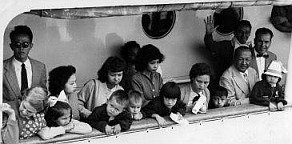
Exploring the history and experiences of mixed heritage persons and inter-racial relationships across the world

Exploring the history and experiences of mixed heritage persons and inter-racial relationships across the world
The term ‘Assimilado’ was used by the Portuguese colonialists to describe colonial subjects that had rejected their respective native cultures and taken on the more ‘civilised’ Portuguese one. The French colonialists also had an assimilation policy, for example, the assimilated were called évolués (literally, the evolved ones) in Algeria. The other colonialists, especially the British, did not have a specific formal system of assimilation. In return for obtaining such a status, the Assimilado obtained certain privileges not available to the ‘savage’ natives.
Over the years, the requirements to obtain this status grew to include education, religious and language aspects and it is no surprise that many of those who met the Assimilado requirements also happened to be mixed race. The early policy of the race mixing encouraged or ignored by many of the colonial administrations resulted in a number of inter-cultural families where the, usually European, husband determined that the children obtained some education, followed Christian ways and spoke his mother tongue. This conferred some economic and sometimes political advantage to his offspring.
The ‘Assimilado advantage’ can be seen in the history of many colonies such as the Indos in Dutch Indonesia and the Assimilados/mestizos of Portuguese Goa, Angola, Mozambique and the Philippines. The higher education and the language advantage meant that many people from these communities performed better economically, usually gainfully employed in better jobs such as the lower ranks of the colonial apparatus, than the poor indigenous populace.
Even though the British are said never to have followed this assimilation thinking, they presided over the removals of the Aboriginal mixed race children, known as the stolen generation, with the view of civilising them enough for them to reject their native, heathen ways. Later, both the British colonies of Rhodesia (now Zambia and Zimbabwe) and South Africa both defined a separate racial class for their mixed population, the Coloureds, who had better rights than the native African citizens, more so in Rhodesia than in South Africa.
Cultural assimilation is said to be the promotion of a dominant culture but in the case of colonial assimilation, it was the minority culture that was being promoted. However, there was also assimilation the other way. Many of the offspring of romantic or other liaisons between European man and indigenous women were not acknowledged and many of these children were assimilated back into the indigenous culture. This happened so often in some societies that there were descriptions given to such individuals such as ‘lost coloured’ in Zimbabwe and ‘disappearing into the kampun (village)’ in Indonesia. For the most part the very earliest, especially in Africa, mixed race children remained in the indigenous societies and occasionally a throwback occurs.
Arguably, the British racist views on miscegenation particularly during the Victorian years appears to have spread to other European countries. In the later period of colonialism, the newly arrived immigrants, many encouraged by their respective governments and arriving with wives and families in tow, were less willing to compete against these local non-European communities. The rules for assimilation were hugely tightened and further opportunities restricted to make way for these mainly working class immigrants.

Arrival of the "Castel Felice" with Indo Eurasian repatriates from Indonesia on Lloydkade in Rotterdam.
Independence for most colonies brought retribution on the mixed race middle classes and in many cases, such as the Goans and Indos, they fled to the ‘mother’ countries to escape the wrath of the people who saw them as part of the colonial structures. In some cases, such as the Philippines and Angola, it was the educated classes that pushed for independence and they remain in powerful political and economic positions in those societies. The ‘coloureds’ of Zimbabwe and South Africa are a bit of an exception and now claim to find themselves on the wrong end of such policies as ‘Black Economic Empowerment’ and ‘indigenisation’.
One thing is for sure, as these colonial middle classes came to Europe they found themselves in the lower social ranks of their new societies, in some cases, even vilified and unaccepted. They, however, form the older immigrant populations and many of their offspring now contribute to the growing mixed race populations of many European nations.
LINKS